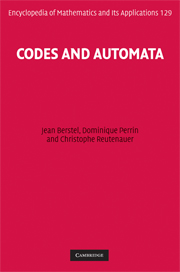Book contents
- Frontmatter
- Contents
- Preface
- 1 Preliminaries
- 2 Codes
- 3 Prefix codes
- 4 Automata
- 5 Deciphering delay
- 6 Bifix codes
- 7 Circular codes
- 8 Factorizations of free monoids
- 9 Unambiguous monoids of relations
- 10 Synchronization
- 11 Groups of codes
- 12 Factorizations of cyclic groups
- 13 Densities
- 14 Polynomials of finite codes
- Solutions of exercises
- Appendix: Research problems
- References
- Index of notation
- Index
Preface
Published online by Cambridge University Press: 05 March 2013
- Frontmatter
- Contents
- Preface
- 1 Preliminaries
- 2 Codes
- 3 Prefix codes
- 4 Automata
- 5 Deciphering delay
- 6 Bifix codes
- 7 Circular codes
- 8 Factorizations of free monoids
- 9 Unambiguous monoids of relations
- 10 Synchronization
- 11 Groups of codes
- 12 Factorizations of cyclic groups
- 13 Densities
- 14 Polynomials of finite codes
- Solutions of exercises
- Appendix: Research problems
- References
- Index of notation
- Index
Summary
This book presents a comprehensive study of the theory of variable length codes. It is a complete reworking of the book Theory of Codes published by the first two authors more than twenty years ago. The present text includes many new results and also contains several additional chapters. Its focus is also broader, in the sense that more emphasis is given to algorithmic questions and to relations with other fields.
The theory of codes takes its origin in the theory of information devised by Shannon in the 1950s. As presented here, it makes use more of combinatorial and algebraic methods than of information theory. Due to the nature of the questions that are raised and solved, this theory has now become clearly a part of theoretical computer science and is strongly related to combinatorics on words, automata theory, formal languages, and the theory of semigroups.
The object of the theory of codes is, from an elementary point of view, the study of the properties concerning factorizations of words into sequences of words taken from a given set. One of the basic techniques used in this book is constructing special automata that perform this kind of parsing. We will show how properties of codes are reflected in combinatorial or algebraic properties of the associated devices.
It is quite remarkable that the problem of encoding as treated here admits a rather simple mathematical formulation: it is the study of embeddings of a free monoid into another. This may be considered to be a basic problem of algebra. There are related problems in other algebraic structures.
Information
- Type
- Chapter
- Information
- Codes and Automata , pp. ix - xivPublisher: Cambridge University PressPrint publication year: 2009
